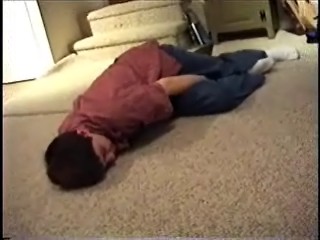For years, the first line in Jerome M. Siegel's research-grant applications simply stated that the cause of narcolepsy is unknown. Time for a new opening line.
Following up on last year's discovery of gene mutations that cause forms of narcolepsy in dogs and mice (SN: 8/14/99, p. 100), Siegel and other investigators have now found that the human brand of this puzzling sleep disorder likely stems from the destruction of a small group of brain cells.
"I don't think this degeneration is the cause of all human narcolepsy, but I'll bet it [accounts for] 90 percent plus, maybe even 99 percent plus," says Siegel of the University of California, Los Angeles. His research team is one of two that identified the cell loss in the preserved brains of people who had narcolepsy when they were alive.
Scientists speculate that they one day may cure narcolepsy or reduce its effects with drugs mimicking secretions of the missing nerve cells or even with braincell transplants. "This is really good news for human narcoleptics because now the pathway for therapy is clear," says Thomas Kilduff of SRI International in Menlo Park, Calif.
In 1880, French physician Jean Baptiste Edouard Gelineau coined the term narcolepsy, from the Greek for sleep attacks, to describe an uncontrollable and frequent need to sleep, even at inappropriate times. Today, physicians use narcolepsy to describe an often mocked but serious illness whose symptoms include sudden bouts of muscle weakness when the person is excited. The disorder afflicts an estimated 200,000 people in the United States.
The new findings on narcolepsy's origins, which appear in the September NATURE MEDICINE and the September NEURON, were revealed several weeks ago at a retreat in Hawaii organized by Emmanuel Mignot of Stanford University. Mignot has managed a colony of narcoleptic dogs for many years and had promised his lab members a trip to Hawaii if they found the gene responsible for the disorder.
Last year, Mignot's group reported that the dogs have a mutation in a gene encoding a cell-surface protein, or receptor, that allows nerve cells to respond to proteins called hypocretins. At the same time, scientists in Texas, who call the same proteins orexins, found that mice lacking the ability to make these neurotransmitters develop symptoms similar to narcolepsy.
Both results triggered a search for mutations in the human genes for the hypocretins and their receptors. Mignot's team, led by Juliette Faraco, quickly studied 74 narcolpetic people. Unexpectedly, they found just one mutation and that was in the rare case of a boy who showed symptoms of narcolepsy as an infant.
The scientists, however, had other evidence that hypocretins are the key to the disorder: The neurotransmitters were missing in the cerebrospinal fluid of most of the narcoleptics they studied.
This suggested to Mignot and other researchers that those nerve cells that secrete hypocretins (found primarily in the brain's hypothalamus) were missing or damaged in narcolepsy. Indeed, when Mignot's colleague Christelle Peyron studied brain tissue from two deceased narcoleptics, he was unable to find any nerve cells containing the genetic instructions to build the hypocretins.
"It's almost like something came in with a scalpel and removed each of these cells," says Mignot, noting that brain cells that would normally be intertwined with the hypocretin-secreting cells were unscathed.
At the Hawaii retreat, Siegel stunned his hosts by reporting almost the same findings: His group had also found a reduced number of hypocretin-making cells in the brains of deceased narcoleptics.
"In the 25 years I've been in science, it was the most exciting meeting I've ever attended," says Kilduff, a former narcolepsy investigator who was part of the research team that discovered the hypocretins 2 years ago.
Siegel's findings do differ somewhat from those of Mignot's team. In the four narcoleptic brains his team studied, 5 to 15 percent of the hypocretin-containing cells remained in place. Furthermore, Siegel and his colleagues documented evidence of gliosis, a proliferation of brain cells called glia, at the site of cell loss.
Gliosis, which is often the result of inflammation within the brain, hints at a possible cause of the brain-cell loss in narcolepsy, says Siegel. For more than 2 decades, scientists have suspected that the disorder is the result of the body's immune system attacking its own tissue.
The gliosis may be the aftermath of such an autoimmune attack, says Siegel. Mignot and his colleagues didn't detect gliosis or other signs of inflammation in the two brains they studied, but he agrees that an autoimmune attack is the most likely cause of the brain-cell loss.
Determining what kills the hypocretin-making cells is crucial. Drugs that limit inflammation could fight narcolepsy if it indeed is an autoimmune disorder. Braincell transplants might also help, but if whatever kills the hypocretin-secreting cells continues even after all such cells are gone, transplants could be a waste of time.
The first option for treating narcolepsy, predicts Kilduff, will be drugs that mimic the missing hypocretins. "To go from discovery of a neurotransmitter system ... to understanding the neuropathology of a disease in 30 months is probably unprecedented," he adds. "This is certainly the most important discovery for narcolepsy since its original description." In fact, Kilduff calls the new work the biggest discovery in sleep research in more than half a century.
COPYRIGHT 2000 Science Service, Inc.
COPYRIGHT 2000 Gale Group



